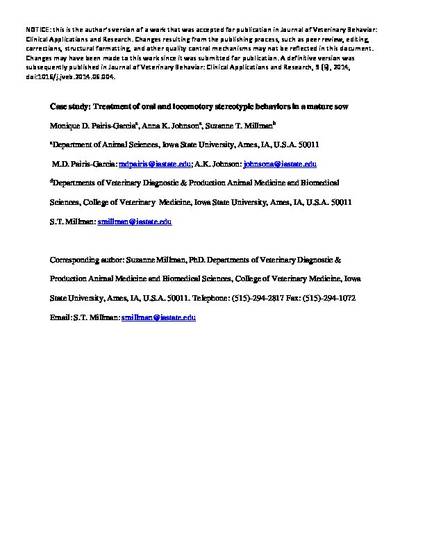
A 32-month-old female 225-kg nonpregnant cross-bred Newsham sow presented a 6-week history of stereotypic behaviors when housed in a laboratory research facility. A behavioral examination over 12 daylight hours revealed 3 main stereotypic motor patterns, namely (1) oral-nasal gate manipulation defined as placement of the snout between the bars of the pen gate with repetitive, forceful up and down movement; (2) head weaving defined as repetitive lateral head and snout movement toward the pen gates while rocking back and forth on her forequarters with hooves remaining on ground at all times; and (3) body weaving defined as repetitive shifting of body weight from one side to the other with front hooves lifting alternately off the ground. The sow performed the oral-nasal gate manipulation and head and body weaving 4.0%, 12.4%, and 6.8% of her total baseline time budget, respectively. The presumptive diagnosis was oral-nasal and locomotory stereotypies. Three treatments were used to mitigate the duration and frequency of these stereotypic behaviors. Treatment 1—Social treatment (change social stimuli by providing visual and nose-to-nose contact with different neighboring sows); Treatment 2—Forage treatment (change foraging substrates by providing peat moss as a rooting substrate); and Treatment 3—Space treatment (change pen configuration by increasing space). The sow performed the oral-nasal gate manipulation and head and body weaving 0%, 0.4%, and 0.1% of her total time budget, respectively; social treatment: the sow performed the oral-nasal gate manipulation and head and body weaving 0.9%, 15.3%, and 11.3% of her total time budget, respectively; and forage treatment: the sow performed the oral-nasal gate manipulation and head and body weaving 0.5%, 28.0%, and 15.5% of her total time budget, respectively. This study is one of the first reports to evaluate the treatment of established stereotypies in a mature sow. Results suggest the promise of environmental enrichment as an effective treatment strategy. Further research is needed to evaluate the persistence of these behavioral changes and relative importance of different environmental manipulations provided.
Available at: http://works.bepress.com/anna_butters-johnson/69/

NOTICE: this is the author’s version of a work that was accepted for publication in Journal of Veterinary Behavior: Clinical Applications and Research. Changes resulting from the publishing process, such as peer review, editing, corrections, structural formatting, and other quality control mechanisms may not be reflected in this document. Changes may have been made to this work since it was submitted for publication. A definitive version was subsequently published in Journal of Veterinary Behavior: Clinical Applications and Research, 9 (5), 2014, doi:1016/j.jveb.2014.06.004. Posted with permission.